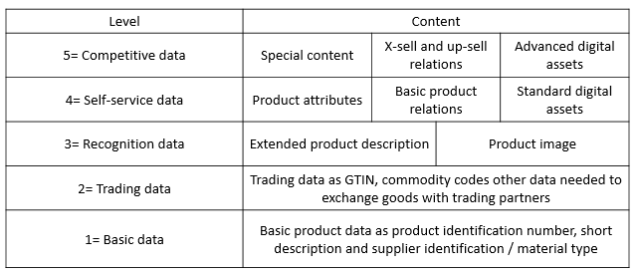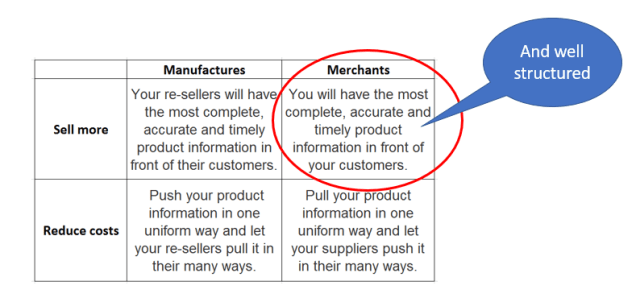When talking about Product Master Data Management (Product MDM) Product Information Management (PIM) I like to divide the different kinds of product data into the schema below:

Level 1, Basic Data
At the first level, we find the basic product data that typically is the minimum required for creating a product in any system of record.
Here we find the primary product identification number or code that is the internal key to all other product data structures and transactions related to the product within an organization.
Then there usually is a short product description. This description helps internal employees identifying a product and distinguishing that product from other products. Most often the product is named in the official language of the company.
If an upstream trading partner produces the product, we may find the identification of that supplier here too. If the product is part of internal production, we may have a material type telling about if it is a raw material, semi-finished product, finished good or packing material.
Level 2, Trading Data
The second level has product data related to trading the product. We may have a unique Global Trade Item Number (GTIN) that may be in the form of an International – former European – Article Number (EAN) or a Universal Product Code (UPC). Here we have commodity codes and a lot of other product data that supports buying, receiving, selling and delivering the product.
Level 3, Recognition Data
On the third level, we find the two basic pieces of product information that came to existence when we started producing product catalogues and had the first ecommerce solutions online.
The extended product description is needed because the usual short product description used internally have no meaning to an outsider as told in the post Customer Friendly Product Master Data. Some good best practices for governing the extended product description is to have a common structure of how the description is written, not to use abbreviations and to have a strict vocabulary as reported in the post Toilet Seats and Data Quality.
We often see that the extended product descriptions need to be present in the range of languages covering the locations where business is done either if the business is international or done in a country with multiple countries. The trend of increased user customization (or should I say customisation) drives this point further.
Having a product image is pivotal if you want to sell something without showing the real product face-to-face with the customer or other end user. A missing product image is a sign of a broken business process for collecting product data as pondered in the post Image Coming Soon.
Level 4, Self-service Data
At the fourth level, we have three main sorts of product information: Product attributes, basic product relations and standard digital assets. These data supports when customers makes buying decisions within eCommerce and other self-service scenarios.
Product attributes are also sometimes called product properties or product features. These are up to thousands of different data elements that describes a product. Some are very common for most products like height, length, weight and colour. Some are very specific to the product category. This challenge is the reason of being for dedicated Product Information Management (PIM) solutions as told in the post MDM Tools Revealed.
Basic product relations are the links between a product and other products like a product that have several different accessories that goes with the product or a product being a successor of another now decommissioned product. Product relations is described further in the post Related Products: The Often Overlooked Facet of PIM.
Standard digital assets are documents like installation guides, line drawings and data sheets as examined in the post Digital Assets and Product MDM.
Level 5, Competitive Data
As the fifth level we find elements like on the fourth level, but usually these are elements that you won’t necessarily apply to all products but only to your top products where you want to stand out from the crowd and distance yourself from your competitors. If you are a reseller, you typically make these data yourself, where level 4 hard facts are delivered from the manufacturer, as examined in the post Using Internal and External Product Information to Win.
Special content are descriptions of and stories about the product above the hard features. Here you tell about why the product is better than other products and in which circumstances the product can to be used. A common aim with these descriptions is also Search Engine Optimization.
X-sell (cross-sell) and up-sell product relations applies to your particular mix of products and may be made subjective as for example to look at up-sell from a profit margin point of view. X-sell and up-sell relations may be defined from upstream by you or your upstream trading partners but also dripping down on the roof from the behaviour of your downstream trading partners / customers as manifested in the classic webshop message: “Those who bought product A also bought / looked at product B”.
Advanced digital assets are broader and more lively material than the hard fact line drawings and other documents. Increasingly newer digital media types as video are used for this purpose.
Product Classification, Product Pricing and Product Lifecycle Status
All of the above-mentioned levels of product information is supported by product classification. Usually we see product classification handled as a reference data type across Product Information Management (PIM), ERP and Product Lifecycle Management (PLM) where applicable.
Product pricing is usually also a subject mainly belonging to the ERP side of things.
Product Lifecycle Status again goes across Product Information Management (PIM), ERP and not at least Product Lifecycle Management (PLM) where applicable.
Master Data Management (MDM) is the discipline that connects the dots between these topics.
Take the processes to next level:
You can take your Product Information Management (PIM) and Product Master Data Management (Product MDM) to a higher level by following the processes as described in the post Using Pull or Push to Get to the Next Level in Product Information Management.




 This reminds me of when we talk about using robots to substitute human labor. Then we often think about a machine that looks like a human. But effective industrial robots do not look like humans. They a designed to do a specific process much more effective than a human and will therefore not look like a human. The same is true in digitalization. When we redesign business processes to be much more effective they should not include spreadsheets.
This reminds me of when we talk about using robots to substitute human labor. Then we often think about a machine that looks like a human. But effective industrial robots do not look like humans. They a designed to do a specific process much more effective than a human and will therefore not look like a human. The same is true in digitalization. When we redesign business processes to be much more effective they should not include spreadsheets.


 But again, there seems to be an enemy angle here too. Who should have the burden of lifting product information as the manufacturers have it to the way it is presented at the point-of-sales provided by the merchant? Often this seems to be stalled in a standoff as described in the post
But again, there seems to be an enemy angle here too. Who should have the burden of lifting product information as the manufacturers have it to the way it is presented at the point-of-sales provided by the merchant? Often this seems to be stalled in a standoff as described in the post  The purpose of the game is to emphasize one of the main reasons of being for Product Data Lake. We want to replace the use of spreadsheets for exchanging product information in cross company supply chains with our automated cloud service.
The purpose of the game is to emphasize one of the main reasons of being for Product Data Lake. We want to replace the use of spreadsheets for exchanging product information in cross company supply chains with our automated cloud service.